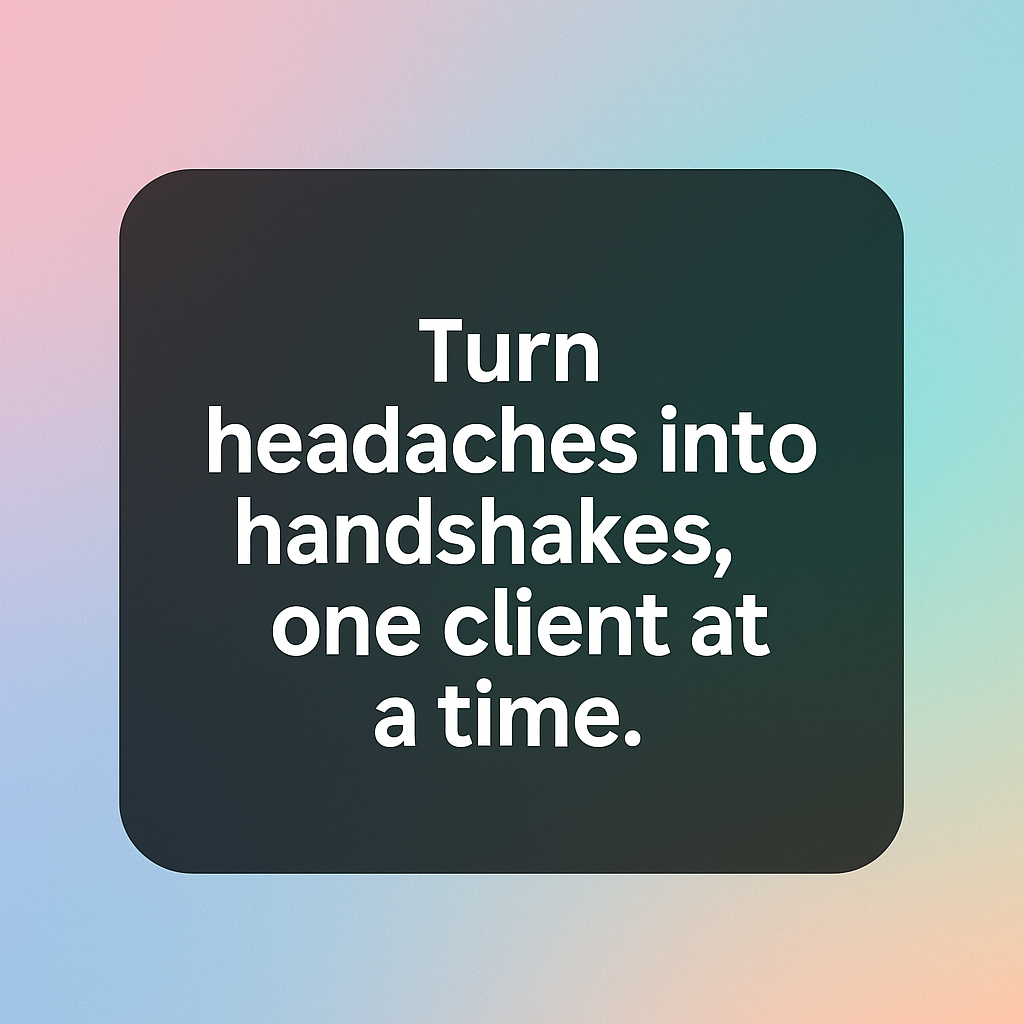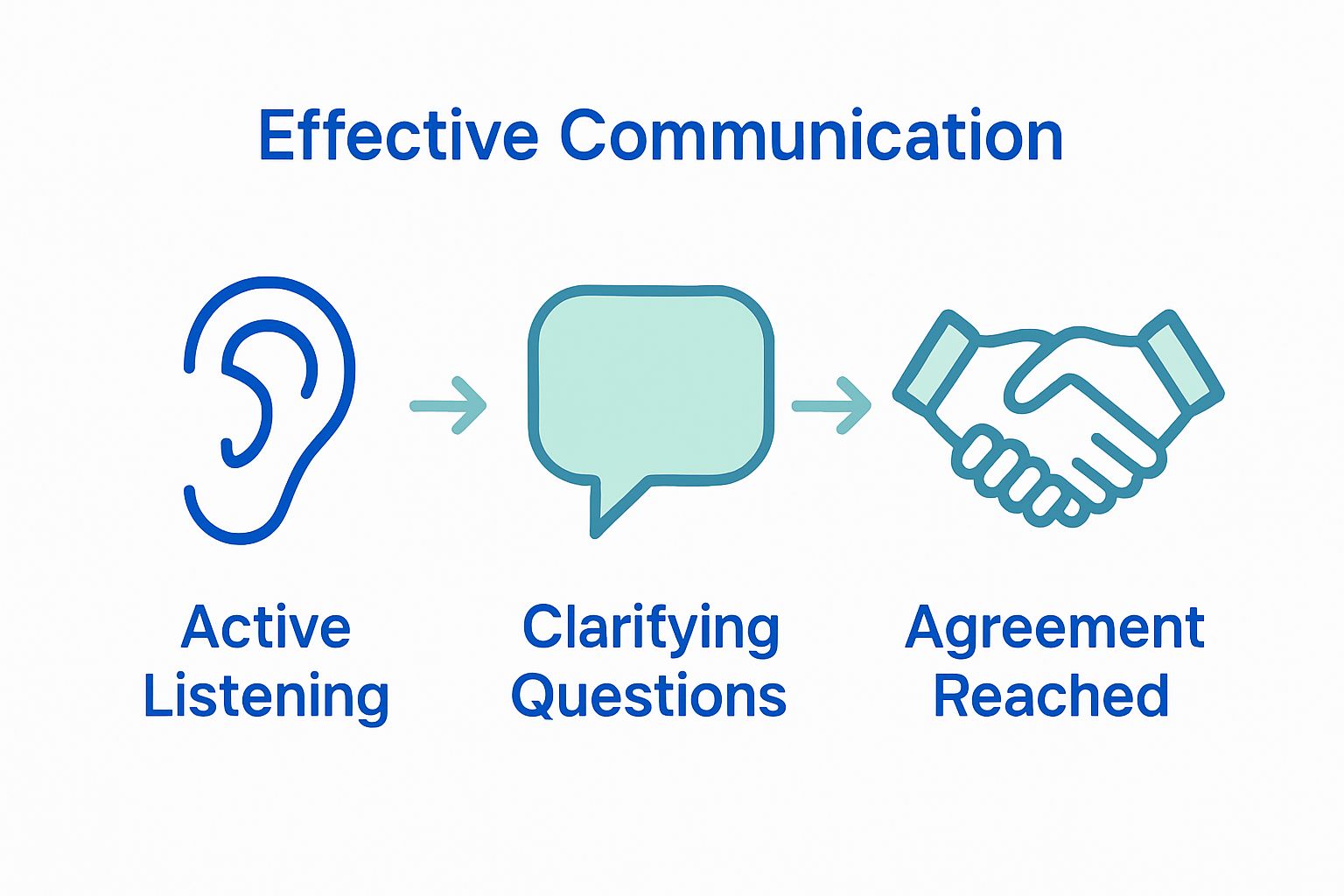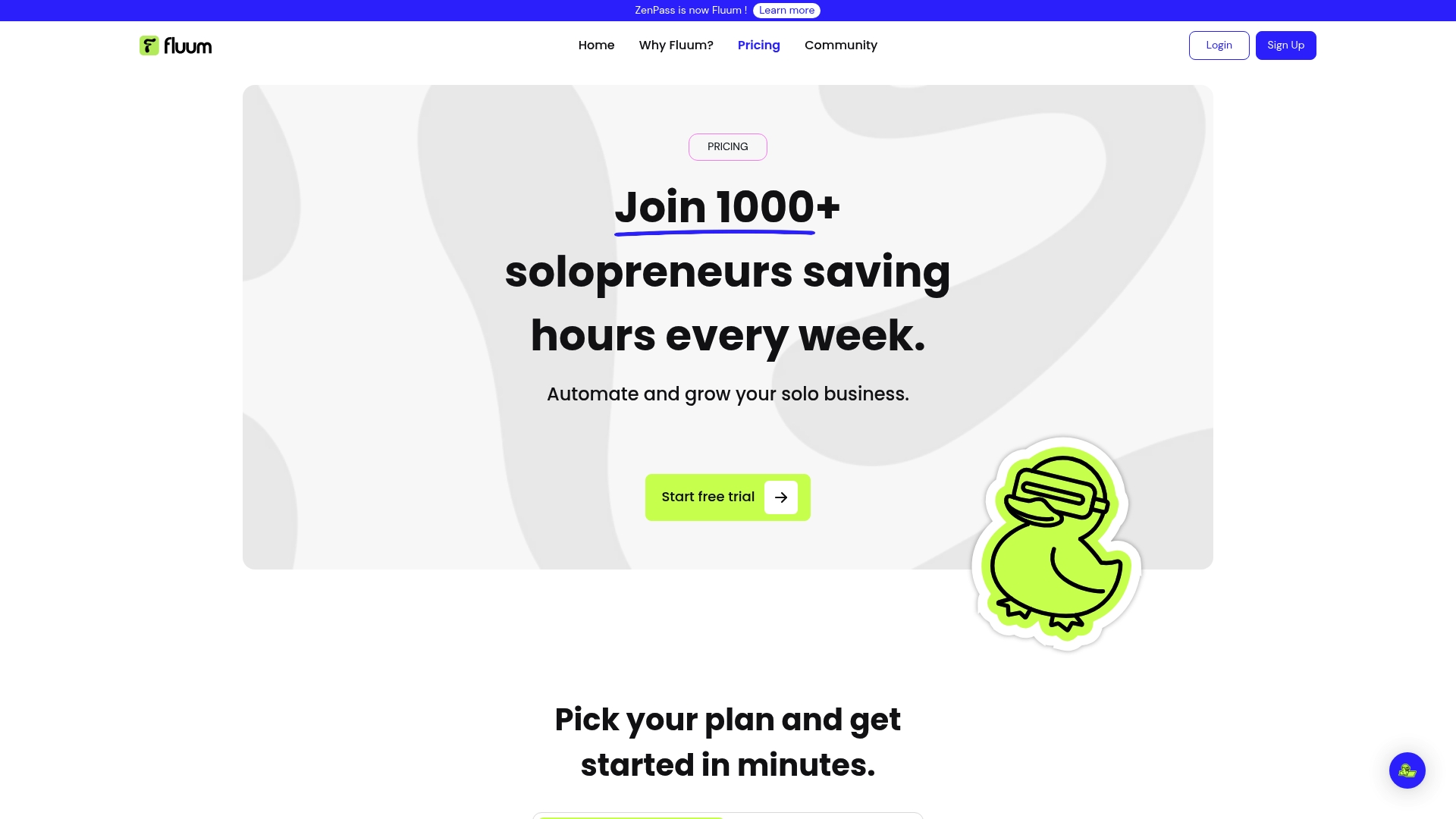
Dealing with difficult clients can feel like walking a tightrope at work. Most people expect these conversations to spiral into conflict, but that’s not what the research says. According to the American Psychological Association, boosting your emotional resilience dramatically improves outcomes during stressful client interactions. The real surprise is that the right mindset before a meeting is often the deciding factor between chaos and a calm, professional solution.
Table of Contents
- Step 1: Prepare Your Mindset for Tough Interactions
- Step 2: Identify Client Needs and Underlying Issues
- Step 3: Communicate Clearly and Set Boundaries
- Step 4: Implement Problem-Solving Techniques
- Step 5: Follow Up and Confirm Client Satisfaction
Quick Summary
| Key Point | Explanation |
|---|---|
| 1. Cultivate Emotional Resilience | Prepare your mindset to stay calm during tough interactions and view conflicts as problem-solving opportunities. |
| 2. Practice Active Listening | Engage in intentional listening to uncover deeper client needs and motivations, which can facilitate collaboration. |
| 3. Set Clear Communication Boundaries | Establish and document boundaries to protect your professional integrity and enhance respect in client interactions. |
| 4. Implement Structured Problem-Solving | Approach client conflicts with a systematic method to identify core issues and develop collaborative solutions. |
| 5. Follow Up to Ensure Client Satisfaction | Regularly check in with clients post-project to demonstrate commitment and gather valuable feedback for improvement. |
Step 1: Prepare Your Mindset for Tough Interactions
Dealing with difficult clients requires more than technical skills. Your mental preparation determines how effectively you navigate challenging professional interactions. Success starts with understanding that client conflicts are rarely personal attacks, but opportunities for constructive problem solving.
Emotional Intelligence Foundations
Before engaging with challenging clients, cultivate a resilient mindset rooted in self awareness. This means recognizing your emotional triggers and developing strategies to remain calm under pressure. According to American Psychological Association research, emotional resilience allows professionals to maintain composure and think strategically during stressful interactions.
Start by acknowledging that every difficult conversation presents a chance to demonstrate professionalism. Your goal is not to win an argument, but to find mutually acceptable solutions. Practice deep breathing techniques before meetings, visualize positive outcomes, and remind yourself that client frustrations typically stem from unmet expectations or communication gaps.
Mental Preparation Strategies
Develop a pre interaction ritual that centers your mindset. This might involve reviewing project details, anticipating potential concerns, and preparing measured responses. Mentally rehearse scenarios where the client might become upset, planning calm, solution oriented language. Create mental scripts that redirect negative energy toward constructive dialogue.
Prepare a professional “emotional shield” by separating your personal feelings from the business interaction. When clients express anger or dissatisfaction, listen actively without becoming defensive. Your composure communicates confidence and competence. Remember that remaining neutral does not mean being passive. It means responding with empathy, clarity, and a commitment to resolving underlying issues.
By investing time in mental preparation, you transform potential conflict zones into collaborative problem solving opportunities. Your prepared mindset becomes your most powerful professional tool in managing challenging client relationships.
To help you quickly scan and implement the main actions for mastering difficult client interactions, here is a step overview table summarizing each key step, its purpose, and the outcome you should expect.
| Step | Purpose | Expected Outcome |
|---|---|---|
| Prepare Your Mindset | Cultivate emotional resilience and self-awareness | Stay calm and professional in tough situations |
| Identify Client Needs | Use active listening and strategic questioning | Reveal root issues and deepen understanding |
| Communicate and Set Boundaries | Deliver clear messages, and reinforce professional standards | Prevent misunderstandings, protect integrity |
| Problem-Solving Techniques | Apply structured frameworks and negotiate | Resolve conflicts constructively, build trust |
| Follow Up | Conduct timely, supportive follow-up and feedback | Enhance satisfaction, foster long-term loyalty |
Step 2: Identify Client Needs and Underlying Issues
Successful client interactions require deep understanding beyond surface level complaints. Identifying genuine client needs transforms potential conflicts into opportunities for meaningful collaboration. This step moves beyond hearing words to comprehending the emotional and professional motivations driving client behavior.
Listening with Strategic Purpose
Effective communication begins with intentional listening. According to scientific research on interpersonal communication, active listening involves more than passive hearing. It demands full engagement, where you absorb not just spoken words but underlying emotional contexts.
Start by creating a safe conversational environment. Signal genuine interest through open body language, maintaining eye contact, and offering verbal acknowledgments. When clients speak, resist the impulse to interrupt or immediately propose solutions. Instead, practice reflective listening techniques where you paraphrase their concerns to confirm understanding.
During conversations, ask strategic clarifying questions that reveal deeper motivations. These questions should be open ended and non confrontational. For example, instead of asking “Are you unhappy?”, frame your inquiry as “What specific aspects of our current approach are not meeting your expectations?”
Decoding Hidden Communication Signals
Clients often communicate frustrations indirectly. Learning to read between the lines helps uncover root issues. Pay attention to tone, hesitation, and emotional undertones. A client complaining about project timelines might actually be expressing anxiety about broader business uncertainties.
Document client interactions meticulously. Take notes during conversations, capturing not just technical details but emotional nuances. This creates a comprehensive understanding of client perspectives and helps track evolving needs. Your documentation becomes a valuable reference for future interactions and demonstrates your commitment to understanding their unique challenges.
By mastering the art of strategic listening and empathetic inquiry, you transform potential confrontations into collaborative problem solving sessions. Each conversation becomes an opportunity to build trust, demonstrate professional expertise, and forge stronger client relationships.

Step 3: Communicate Clearly and Set Boundaries
Communication serves as the cornerstone of managing difficult client relationships. Clear boundaries protect your professional integrity and create a framework for respectful interactions. This step transforms potential conflicts into structured, productive conversations where both parties understand expectations and limitations.
Professional Communication Strategies
According to American Psychological Association research, establishing healthy boundaries prevents professional burnout and maintains relationship quality. Begin by developing a communication approach that balances empathy with professional distance. Use direct, neutral language that leaves no room for misinterpretation.
Verbal communication should be calm, concise, and solution oriented. Practice delivering messages that are both firm and constructive. For instance, instead of saying “That’s impossible,” reframe challenges as “Let’s explore alternative approaches that align with our project constraints.” Learn more about setting boundaries with clients effectively to refine your communication skills.
Document communication expectations early in professional relationships. Create a clear outline of response times, preferred communication channels, and project interaction protocols. This proactive approach sets realistic expectations and reduces potential misunderstandings.
Consider developing a simple client communication agreement that both parties can reference.
Boundary Reinforcement Techniques
When clients push against established boundaries, respond consistently and professionally. Do not apologize for maintaining your professional standards. If a client becomes demanding or unreasonable, redirect the conversation to specific project parameters. Use phrases that acknowledge their concern while reaffirming your professional limitations.
Technology can support your boundary setting efforts. Utilize scheduling tools that allow specific communication windows, set automatic email responses during non business hours, and create templated responses for recurring situations. These systems help you maintain professionalism without constant manual intervention.
Remember that boundary setting is an ongoing process. Regularly reassess and adjust your communication strategies based on client interactions. Your goal is creating a respectful, productive professional relationship where both parties feel heard and valued.
Here is a quick checklist table summarizing practical communication boundary strategies mentioned in this section to ensure you establish and maintain professionalism throughout your client interactions.
| Strategy | Description | Benefit |
|---|---|---|
| Document Expectations | Clearly outline response times, preferred channels, and protocols | Sets clear standards, reduces confusion |
| Use Direct, Neutral Language | Deliver messages that are firm but empathetic | Avoids misinterpretation, maintains respect |
| Reinforce Boundaries Consistently | Redirect conversations to project parameters as needed | Prevents scope creep, preserves professionalism |
| Leverage Technology Tools | Use scheduling apps and automated replies | Streamlines communication, protects work-life balance |
| Review and Adjust Regularly | Assess boundaries based on evolving interactions | Keeps relationship productive, adapts as needed |
Step 4: Implement Problem-Solving Techniques
Effective problem solving transforms client conflicts from potential disasters into opportunities for strengthening professional relationships. Strategic resolution requires a systematic approach that balances emotional intelligence with logical analysis. This step equips you with practical techniques to navigate complex client challenges constructively.
Structured Problem-Solving Framework
According to research on conflict management, successful problem solving follows a disciplined methodology. Begin by clearly defining the core issue, separating symptoms from root causes. When a client expresses frustration, resist the impulse to offer immediate solutions. Instead, ask probing questions that help you understand the underlying concerns.
Develop a collaborative approach where the client feels like a partner in resolution. Use language that invites joint problem solving. For example, “I understand your concern. Let’s work together to find a solution that meets your project objectives.” This approach shifts the dynamic from confrontational to cooperative.
Create a systematic process for addressing client issues. This might involve documenting the problem, brainstorming potential solutions, evaluating each option’s feasibility, and agreeing on a specific action plan. Learn more about advanced client management strategies to refine your approach.
Negotiation and Compromise Strategies
Negotiation is an art of finding mutually acceptable solutions. Prepare multiple scenarios before client meetings, anticipating potential objections and having alternative proposals ready. Your goal is not to win an argument but to reach a resolution that preserves the professional relationship.
When presenting solutions, focus on tangible benefits. Use concrete examples and data to support your recommendations. If a client pushes back, ask clarifying questions that help you understand their perspective. Sometimes, the most effective solution emerges from listening carefully and showing genuine commitment to addressing their concerns.
Document all agreed upon solutions in writing. Send a follow up email summarizing the discussion, action items, and next steps. This creates accountability and provides a clear reference point for future interactions. By implementing these structured problem solving techniques, you transform potential conflicts into opportunities for building trust and demonstrating professional expertise.
Step 5: Follow Up and Confirm Client Satisfaction
Client satisfaction is not a destination but an ongoing journey that requires consistent attention and proactive communication. Strategic follow up transforms transactional interactions into long term professional relationships. This step focuses on creating meaningful post project engagement that reinforces trust and demonstrates your commitment to client success.
Systematic Follow Up Approach
According to scientific research on client communication, timely and thoughtful follow up significantly enhances client perception and loyalty. Design a structured follow up process that goes beyond standard check in emails. Develop a personalized approach that shows you genuinely care about their experience and outcomes.
Schedule follow up communications at strategic intervals. Within one week after project completion, send a comprehensive review email that summarizes achievements, reflects on challenges overcome, and invites candid feedback. Learn more about improving client experience to refine your approach.
Create a feedback mechanism that feels supportive, not invasive. Use open ended questions that encourage honest reflection. For example, “What aspects of our collaboration exceeded your expectations?” or “Where do you see opportunities for improvement in our future work together?” These questions demonstrate professional humility and commitment to continuous growth.
Turning Feedback into Opportunity
Treat client feedback as a valuable resource for professional development. When clients share critiques, respond with appreciation and specific action plans. If a client mentions a communication gap, outline concrete steps you will take to enhance future interactions. This approach transforms potential criticism into an opportunity to strengthen the professional relationship.
Develop a systematic method for tracking and implementing client feedback. Create a simple spreadsheet or use a customer relationship management tool to document insights. Look for patterns in client suggestions that could inform broader improvements in your professional practice.
Remember that follow up is not a one time event but an ongoing dialogue. By consistently demonstrating your commitment to client satisfaction, you position yourself as a trusted professional who values long term relationships over short term transactions.

Ready to Turn Difficult Clients Into Loyal Fans?
If you’re tired of feeling overwhelmed by tough client interactions, it’s time to transform your approach. The strategies in “Master Dealing with Difficult Clients” highlight the power of clear boundaries, emotional intelligence, and structured follow-up. But even the most prepared solopreneurs and freelancers can struggle if business systems are scattered and manual. Imagine what you could achieve with all your client management, communication, and project follow-up in one place.

With Fluum, you get more than advice. You unlock an all-in-one platform where AI-powered tools help you set boundaries, automate follow-ups, and create seamless experiences for every client. Access templates for clear communication, reliable booking, and fast payments. Grow your service business with less friction and more confidence. Visit our pricing page now to discover how Fluum can make those tough clients easier to manage, and your growth unstoppable. Start your journey today for immediate results in professionalism and peace of mind.
Frequently Asked Questions
How can I prepare my mindset for dealing with difficult clients?
To prepare your mindset, practice self-awareness and develop emotional resilience. List your emotional triggers and rehearse calming techniques, such as deep breathing, before meetings to maintain composure during tough interactions.
What strategies can I use to identify underlying issues with clients?
Use active listening to engage clients fully and ask open-ended, clarifying questions during discussions. For instance, instead of asking if they are unhappy, inquire about what specific aspects of your work are not meeting their expectations.
How can I set clear communication boundaries with clients?
Establish clear boundaries by detailing communication expectations upfront, such as response times and preferred contact methods. Create a simple client communication agreement to refer back to when needed, which helps reduce misunderstandings.
What steps can I take to implement effective problem-solving techniques?
Start by defining the core issue clearly and involve the client in finding a resolution. Document the problem, brainstorm solutions together, and agree on a specific action plan to ensure accountability and clarity moving forward.
How should I follow up with clients to confirm their satisfaction?
Schedule a follow-up email within one week after project completion to summarize achievements and seek feedback. Use open-ended questions to invite honest reflections, such as asking what aspects of the project exceeded their expectations.
How can I turn client feedback into actionable improvements?
Treat client feedback as a valuable resource by responding with appreciation and outlining specific action plans. Track and implement suggestions systematically to address any highlighted issues, aiming to make meaningful changes within your next project cycle.
Recommended
- Fluum | Effective Stress Management Techniques for Busy Professionals
- Fluum | How to Onboard Clients Effectively for Lasting Success
- Fluum | Master Managing Multiple Projects for Success
- Fluum | Build Your Brand with a Branding Builder in 2025
- Fluum | 7 Customer Retention Examples to Boost Your Business



